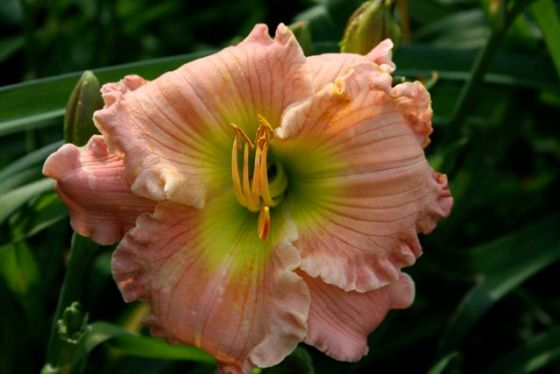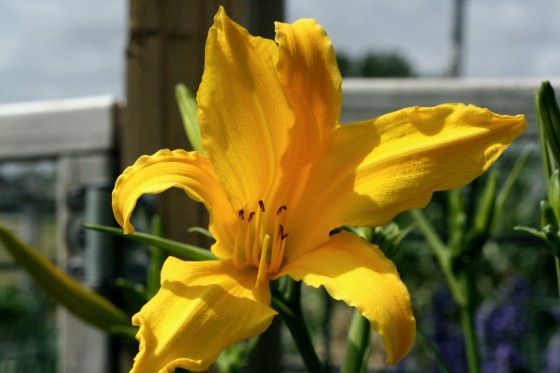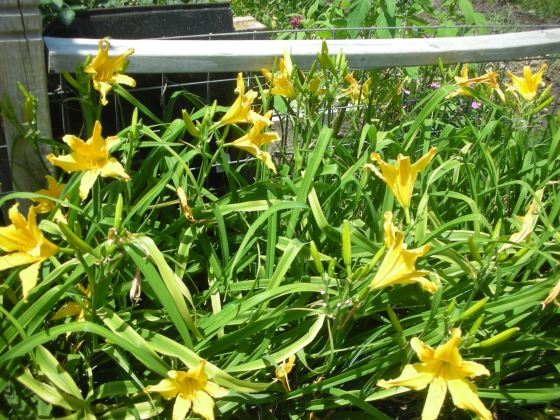Very few plants in my garden give me as much enjoyment as my daylilies. Early in April, I start watching them. I am looking for that first sign of stalks. When I see these I know that soon, the green border around my potager will be covered in bright yellow flowers.
My daylilies were passed to me by my wife’s grandmother. Not directly, though. A few years after she passed, we dug them up from her home place in the sandy loam of East Texas and moved them to the black clay of Washington County. This sentence should tell you a lot about daylilies. First, they lived at Nana’s for several years with absolutely no care. So, daylilies are tough. They also survived being dug out of a beautiful loamy soil and moved to a not so wonderful black clay. So, daylilies are adaptable. Throw in the fact that they are absolutely reliable, pest free and beautiful and you begin to understand why so many people love them.

A lovely daylily bred by Chris von Kohn. You can buy this and others from him. All of his contact info is at the bottom of the post.
History – Daylilies originated in China, Korea and Japan. They found their way to the Americas by the 1700s. The Tawny Daylily was one of the first. It quickly escaped cultivation and is now so common on the east coast that many think it is a native wildflower. This flower was often planted close to outhouses and so it derived the very unfortunate common name of “Outhouse Lily”. Daylilies began to lose their popularity in the US in the 1800s. In 1920, the “Hyperion” daylily was introduced. This began the resurrection of the flower as a major bedding plant in American gardens.
Despite their name, they are not true lilies. Daylilies belong to the genus Hemerocallis and there are over 60,000 registered cultivars. Their name is derived from Greek and literally means “beautiful day”. Since the 1950s, the US has been the world leader in daylily hybridization. I have a young friend at A&M named Chris von Kohn. He has already created over 1000 daylily hybrids. He hasn’t gotten one named yet, but he is only 22! Chris is an up and coming Master of Horticulture and I am betting that we are going to be hearing a lot more about him in the years to come. Thanks to the efforts of people like Chris, you can now own daylilies in every color except blue. Some have a strong fragrance and others have none. There are daylilies with ruffled petals and multi-colored petals. Some have “eyes” and still other sparkle with “diamond dust”.

Another lovely daylily bred by Chris von Kohn. He is about to start grad school so he will greatly appreciate every order. All of his contact info is at the bottom of the post.
Planting – Daylilies are incredibly easy to grow. Plant them in direct sun (or dappled shade) in well worked soil. Dig a hole about 8” deep and make a small mound in the center of the base. Spread the roots of the plant over this mound and backfill to a point where there is no more than 1” of soil over the crown. If the roots of the plant are too big for the hole, trim them. Water them in and then apply mulch (but not around the crown). Water regularly for the first year. After that, the daylily should be able to survive with minimal amounts of supplemental water.
Dividing – Daylilies reproduce rapidly. If their clumps become too dense, they will begin to flower less and less. Because of this, you need to divide them every two or three years. This is best done in late summer or early fall. Also, it is a good idea to give your plants a good watering the day before you do your dividing and transplanting.
There are two ways to divide your plants. The easiest is to just stick your shovel in the middle of the clump and remove half of the plant. Since they have an extensive root system you may need to push your shovel all the way into the soil. Use the shovel to work around the new clump and remove. Replant in a prepared hole at the same depth as the original plant and water. Place them about two feet apart.

Another creation of Chris von Kohn. You can buy this and others from him. All of his contact info is at the bottom of the post.
If you want to get individual plants, you can use a sharp knife to divide your clump into fourths. Once this done, you can begin to remove individual fans. Replant these fans like previously described.
Very few beautiful plants are as hardy or as easy to grow as Daylilies. There are varieties that are hardy from zones 1 to 11. Once established, they have a low water requirement and they are relatively pest free. On top of all of that, they are incredibly diverse in color and form. With so much to offer there is no reason for you not to grow daylilies in your own garden.
Buy Your Daylilies Here – Chris von Kohn will be selling some of his creations this fall. They are incredible! He is currently taking orders. They are in bloom now so if you live in the Arlington/DFW area you can go by and pick your favorite. He will mark it and save it for you and you can pick it up in the fall. You can reach Chris at cvk007@earthlink.net or you can give him a call at either 817-269-7474 or 817-483-5146. If you don’t live in the DFW area, just drop him an e-mail and he will be happy to send you pictures and then ship your plants when they are ready.





Pingback: Great Deal on Daylilies | The Masters of Horticulture